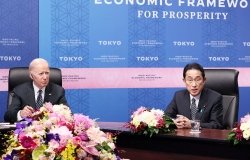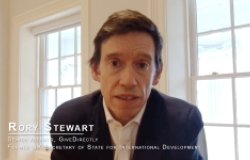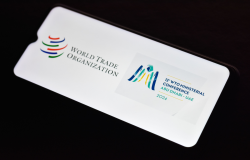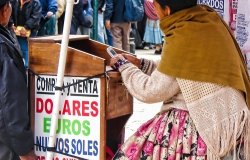Living on $2 a Day: A Finance System for the "Bottom Billion"
Daryl Collins and Jonathan Morduch share insights from their book about the sophisticated ways by which people living in poverty manage their finances.
Overview
On September 29, 2009, the Wilson Center on the Hill and the Environmental Change and Security Program hosted a discussion about the sophisticated ways by which the world's poor manage their finances. Daryl Collins, senior associate at Bankable Frontier Associates, and Jonathan Morduch, a Professor of Public Policy and Economics at New York University, shared some insights from their book, Portfolios of the Poor: How the World's Poor Live on $2 a Day. Geoff Dabelko, the Director of the Environmental Change and Security Program moderated the event.
The question at the core of their research is how people actually live on $2 a day. As Morduch pointed out the idea of living on $2 a day seems like a remote concept to many in the western world. However, contrary to the popular notions that poor people are "living hand to mouth" and are not able to save, the researchers found they in fact live very active financial lives.
To gauge how people use their money over long periods of time, field researchers utilized long-term, detailed financial diaries that focused on how people in India, Bangladesh, and South Africa managed their money and paid for the basic necessities of family life. They went to each participant's house every two weeks and wrote down each person's income, expenses, and cash flows for the previous two weeks. Collins said that they tried to "let the numbers speak for themselves" and make the research as clinical as possible.
 Collins outlined four lessons learned from their research. The first is that the poor are very active managers of money and utilize both formal and informal sectors. In India, for example, the researchers found that participants recreated their portfolios and financial instruments almost every two weeks. The poor would "warp their portfolios" to suit whatever situation they were in. Even though they had small balances, they spent enormous amounts of time managing their funds and utilized diverse types of financial instruments. She noted that if there were products and delivery mechanisms that allowed the poor to simplify their finances, they could utilize that extra time and brainpower for other purposes.
Collins outlined four lessons learned from their research. The first is that the poor are very active managers of money and utilize both formal and informal sectors. In India, for example, the researchers found that participants recreated their portfolios and financial instruments almost every two weeks. The poor would "warp their portfolios" to suit whatever situation they were in. Even though they had small balances, they spent enormous amounts of time managing their funds and utilized diverse types of financial instruments. She noted that if there were products and delivery mechanisms that allowed the poor to simplify their finances, they could utilize that extra time and brainpower for other purposes.
The second lesson is that the poor face "a triple whammy." They have to deal with low incomes that come at irregular intervals, while simultaneously dealing with unpredictable expenses. Unlike those who are paid a salary on a regular basis and can utilize automatic deductions to pay off their loans, many of the poor do not utilize financial services to manage their cash flows. In fact, at present there are not many of these services available to the poor. Without access to financial services it is difficult for poor people to patch the ebbs and flows of expenses.
The third lesson is that the poor are committed to savings. In South Africa for instance, poor people saved on average about 26 percent of their income every month. The problem is that most do not save for longer than a year. The study found that many people save money for predictable expenses, such as Christmas and school fees and use informal savings clubs. Savings clubs are small groups of people who pool their money together, and then put it under charge of an individual, who reimburses them at a later time. The researchers found that savings clubs are a very powerful commitment device because they bind the members together. However, these clubs have two key disadvantages: 1) the natural cycle of these clubs encourage only yearly savings, and 2) due to theft and fraud, these clubs can be unreliable. In addition, Collins noted that the poor rarely earn interest on their savings – in fact, most savings systems for the poor actually charge for the opportunity to save.
The fourth lesson is that unexpected events such as fires, illness, and funerals frequently affect many households. Many do not have a secure pool of savings or insurance from which to draw and are unprotected from the financial impact of these events. Collins said that instead of having to draw on dozens of informal sources to pay for a sudden, unexpected event, a single financial tool would make it easier for them.
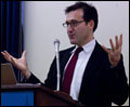 Morduch spoke about the need to "unbox" our thinking and to look for creative solutions to address these needs. He said that there is immense power to affect change when people have financial stability. For instance, modeling formal financial instruments after positive aspects of informal savings clubs can be useful for the poor. In a case study in the Philippines, people who committed to regularly depositing money into a commercial bank account had a savings rate increase of 85%. Another tool that can be creatively adapted to meet the needs of the poor is microfinance—small, formal credit markets. In one such adaptation, water.org, the drive to provide potable water access for the poor is put within the framework of micro-lending.
Morduch spoke about the need to "unbox" our thinking and to look for creative solutions to address these needs. He said that there is immense power to affect change when people have financial stability. For instance, modeling formal financial instruments after positive aspects of informal savings clubs can be useful for the poor. In a case study in the Philippines, people who committed to regularly depositing money into a commercial bank account had a savings rate increase of 85%. Another tool that can be creatively adapted to meet the needs of the poor is microfinance—small, formal credit markets. In one such adaptation, water.org, the drive to provide potable water access for the poor is put within the framework of micro-lending.
A member of the audience asked what role the U.S. should play with regard to these issues. Collins responded by saying that we should broaden microfinance and think of it beyond only finance for small businesses. In order for small businesses to keep functioning, they do not just need capital loans; they need working capital and basic financial tools. She suggested trying to structure financial products around the mechanisms that make the informal devices work and appealing to the poor. Morduch responded that while the focus should remain on the poorest, policy-makers should not ignore the missing middle—the small businesses. He added that governments should create more responsive regulation that would allow banking institutions to break the traditional models of banking. Finally, he pointed out the disadvantages of the current "policy silos." Because finance is an integral part of various other policies such as education, environmental, and health policy, it should be integrated into those policy areas. People, for instance, could borrow money specifically to get solar panels and cooking stoves, which could lead to both environmental and economic sustainability.
Drafted by Matthew Clarkson.
Speakers
Hosted By

Environmental Change and Security Program
The Environmental Change and Security Program (ECSP) explores the connections between environmental change, health, and population dynamics and their links to conflict, human insecurity, and foreign policy. Read more
Thank you for your interest in this event. Please send any feedback or questions to our Events staff.
